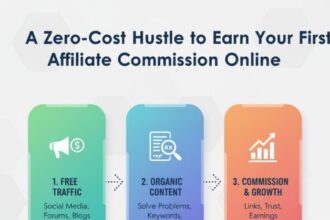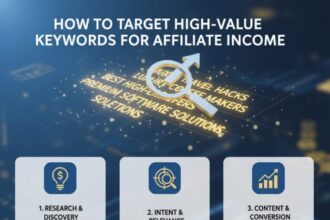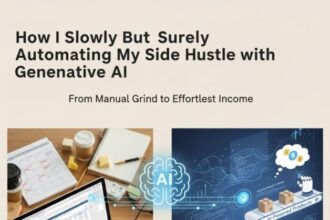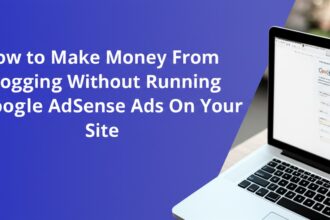Seriously, What Makes You Think Your Business Doesn’t Need a Website? My Own Awkward Journey.
The woman smiled, holding my hand-painted coffee mug in her hands, turning it over to see the little logo I’d stamped on the bottom. We were at a bustling weekend market, the air thick with the smell of kettle corn and fresh-cut flowers. It was a good day. Sales were steady.
“I love this,” she said. “It’s for my sister. Do you have a card? Or a website I can look at later? I’d love to see what else you have.”
And there it was. The question.
I returned her warm smile with one that probably felt a little tight, a little plastic. “Oh! Thank you so much! I don’t have a proper website right now, but you can find me on Instagram! All my new stuff goes up there first.”
Her smile didn’t vanish, but it… changed. A tiny, almost imperceptible shift. It was the look of someone being given a slight inconvenience they were too polite to acknowledge. “Oh, okay. Great,” she said, her voice a little less bright. She bought the mug, and she was lovely.
But as she walked away, I felt a familiar pang of something I couldn’t quite name. Was it embarrassment? Frustration? It felt like I’d just handed a master chef my business plan scribbled on a napkin.
This was the fifth time it had happened that afternoon. And it finally forced me to ask myself the big, scary question I’d been avoiding for years. Honestly, what makes you think your business doesn’t need a website? I wasn’t just thinking about other people anymore. I was staring right in the mirror.
My little side-hustle pottery business felt real in my hands and at this market. In my little studio, covered in clay, it felt important. But out in the world, trying to explain its existence without a digital home base, it suddenly felt… flimsy. Like a hobby that was just pretending.
And so, my journey began. It wasn’t a journey to become a web developer or a marketing guru. Heavens, no. It was a confused, often frustrating tumble down a deep rabbit hole to figure out why I was so resistant to this one, seemingly obvious, business step. And what I found… well, it surprised me. It wasn’t what I expected at all.
My First Clumsy Steps Into the Weird World of Being Online (For Real)
So, like most people, I started where all modern quests begin: Google.
My initial searches were vague. Things like “do I need a website” and “how to sell things without a website.” Because, you see, I was actively trying to find validation for what I was already doing. Or, rather, not doing. I wanted some expert, somewhere, to tell me, “Don’t worry about it! Social media is plenty!
The problem is, nobody really says that. Not anymore.
Instead, I was hit with a tidal wave of articles, blog posts, and videos. They were all screaming at me with a million different acronyms and buzzwords. SEO. CRM. CMS. HTML. CSS. Hosting. Domains. It was an alphabet soup of tech jargon, and frankly, I felt like I was drowning.
Consequently, my brain immediately shut down. This, I told myself, is a different world for a different kind of person. A “tech person.” I’m a “clay and glaze person.” It’s just not for me.
My logic seemed sound at the time. I had a pretty decent Instagram following. People liked my posts, they commented, they even DMed me to buy things sometimes. In my mind, that was my online presence. I truly believed my social media presence is enough. It felt like a perfectly valid, modern-day substitute. Why complicate things?
Of course, the more I half-heartedly dug, the more I realized this was a bit like saying your P.O. Box is a perfectly good substitute for a house. Sure, people can send you letters there. But you can’t live in it. You don’t own it. And the landlord can change the lock whenever they feel like it.
Drowning in Developer-Speak
I think the biggest hurdle, right at the beginning, was the language. Everything I read seemed to be written by developers, for developers. They talked about “back-end infrastructure” and “front-end frameworks” and “server-side scripting.”
Honestly, it felt deliberately intimidating.
It created this immediate barrier, a mental wall that screamed, “You are not qualified to even think about this.” As you can imagine, this just fed my confirmation bias. See? It’s too complicated. It’s too technical. I’m right to avoid this.
Every article that tried to “simplify” it for me just introduced three new terms I didn’t understand. I remember reading about “choosing a domain name” and then immediately getting bogged down in a sub-discussion about TLDs, domain privacy, and DNS settings.
I slammed my laptop shut. It was just too much. For someone who just wants to sell some coffee mugs, being asked to understand how the internet’s global address book works feels like a monumental, unnecessary task. Right?
The First Price Tag I Saw (and My Mini Heart Attack)
Defeated by the jargon, I decided to try another angle. I figured, okay, if I can’t build it, maybe I can just pay someone to do it. Easy. Simple.
So I looked up “local web designers.”
The first portfolio I clicked on was beautiful. The websites were slick, professional, and everything I secretly dreamed of. I found the “Contact Us” form and filled it out, describing my little pottery business and what I thought I needed. You know, a few pages, a gallery, a way for people to buy things.
An email came back the next day. It was very polite, very professional. And at the bottom was a quote.
I’m pretty sure my heart stopped for a solid three seconds.
The figure was more than I had made in the last six months of selling pottery. In fact, it was probably close to what I made in a year. The sheer cost of website development was so far beyond my reality that it was almost laughable.
And there it was. My second, and much more powerful, excuse. My trump card. “I can’t afford it.” It wasn’t just an excuse anymore; it felt like a fact. An insurmountable wall. There was simply no way my small-scale, handmade business could justify that kind of expense.
So, I officially gave up. For a while, at least. I told myself my gut was right all along. It’s too complicated and it’s too expensive. My Instagram page, my market stalls—that was my business. And it would have to be enough.
It’s funny how we build these narratives for ourselves, isn’t it? These perfectly logical, completely sound-looking cages of our own design.
Turns Out, Most of My Excuses Were… Well, Just Excuses
After my “quote-induced coma,” as I now call it, I put the whole website thing out of my mind. I leaned into my markets and my social media. I posted more, I engaged more, I tried to convince myself that this was the path.
But that question kept popping up. From customers. From my well-meaning dad. From my own nagging inner voice late at night. “Do you have a website?”
Eventually, the frustration of not having an answer became greater than the frustration of trying to find one. So, I went back. This time, however, I approached it differently. I wasn’t looking for a “how-to” guide. I was looking for the “why.” Why did everyone insist this was so important? What was I missing?
This led me down a different kind of rabbit hole. One that was less about code and more about human behavior. And this is where I started to realize that my very logical, very solid excuses were mostly made of straw.
Misconception 1: “My Instagram/Facebook Page is My Real Website”
This was my biggest mental block. I’d spent ages curating a beautiful Instagram feed. The photos were nice! The captions were quippy! People seemed to like it! For all intents and purposes, it was my business online.
The more I read, however, the more I saw the flaws in this logic. It’s not about whether your page is good; it’s about the platform itself.
For starters, you have zero control. Social media platforms are notorious for changing their algorithms on a whim. One day, your posts are getting seen by hundreds of your followers. The next, a new update rolls out, and suddenly your reach plummets unless you pay for ads. You’re building your business on borrowed land, and the landlord is unpredictable and frankly, a bit greedy.
Then there’s the issue of function. A social media profile is a terrible catalogue. Trying to find an old post about a specific type of bowl I made six months ago? Good luck. It’s a reverse-chronological mess. A website allows you to organize information logically. You can have a page for mugs, a page for bowls, a page for your story, and a clear contact page. You are the architect.
Finally, and this was a big one for me, you don’t own your audience. You have “followers,” but you can’t directly communicate with all of them. The platform can (and does) limit who sees your content. As I learned from a fantastic Forbes article, if the platform were to shut down tomorrow, your audience would simply vanish. A website, especially with an email list, gives you a direct line to the people who are most interested in your work. That’s a real asset.
Basically, my social media page wasn’t a home. It was a billboard on a very crowded, ever-changing highway.
Misconception 2: “I’m a Local Shop, People Find Me in Person Anyway”
My other big excuse was the nature of my business. I sell physical things, often face-to-face at local markets. People can see, touch, and buy my work right there. Why would I need a website for that? This is where the idea of local business online visibility came in and smacked me right in the face.
I started thinking about my own behavior as a consumer.
If I need to find a new local pizza place, what do I do? I pull out my phone and search “pizza near me.” If I need a plumber, I search “plumber in [my town].” I almost never just wander the streets hoping to stumble upon what I need.
And what do I do when I see a list of results? I click on the links. I check out their websites.
If a business doesn’t have a website, a little part of my brain immediately flags it as less legitimate. Are they still in business? What are their hours? Can I see a menu or a list of services? Without a website, all of those simple questions remain unanswered, and I will, 100% of the time, just move on to the next result that does have a website.
I was expecting my customers to behave in a way that I myself do not.
A website acts as your digital signpost. It tells search engines like Google that you exist, you’re located here, and this is what you do. So, when someone—even someone in my own neighborhood—searches for “handmade pottery gifts near me,” a website gives me a chance to actually show up in those results. Without it, I’m practically invisible to the vast majority of modern local customers.
My market stall was only open for 8 hours on a Saturday. A website is open 24/7, working for me even when I’m sleeping.
Misconception 3: “It’s Pointless, I Can’t Compete with the Big Guys Anyway”
This was more of an underlying feeling than a specific excuse. I sell handmade ceramics. How could my tiny one-person show ever compete online with massive retailers like West Elm or even a platform like Etsy? Why bother entering a race you know you’ll lose?
The more I learned, the more I realized I was thinking about it all wrong. The goal isn’t to compete with them. The goal is to stand apart from them.
And a personal website is the single best tool to do that.
A giant retailer can’t tell a personal story the way I can. They can’t show a picture of me, with clay all over my jeans, pulling a new piece off the wheel. They can’t write a blog post about the inspiration I got from a recent hike in the mountains. They compete on price and volume. I compete on story, personality, and connection.
Your website is your home turf. It’s where you get to control the narrative completely. It’s your always-on digital storefront where the shelves are stocked not just with your products, but with your personality and your passion.
People who want a cheap, mass-produced mug will go to a big box store. But people who want a unique piece with a story behind it, made by a real person they feel a connection to—they are looking for someone just like me. A website is how they find me. It’s not about competing; it’s about attracting my specific people.
Suddenly, it wasn’t a daunting chore anymore. It was starting to feel like an opportunity. An exciting one.
The One Simple Idea That Finally Made Having a Website Click for Me
I’d spent weeks, maybe months, circling this whole topic. I’d battled jargon, recoiled from quotes, and slowly dismantled my own excuses. I understood, on an intellectual level, why a website was a good idea. I got the logic behind it.
But it still felt like a task. A box to be checked. Another thing to add to my already overflowing to-do list.
The real shift—the “Aha!” moment—didn’t come from a tech blog or a marketing seminar. It came when I was thinking about that woman at the market. The one who asked for my website and got my Instagram handle instead. I kept replaying that tiny, fleeting look on her face. It wasn’t frustration. It wasn’t annoyance.
It was uncertainty.
And that’s when it hit me. The one simple idea that changed everything.
A website isn’t about sales. It isn’t about marketing. It isn’t about SEO or code or any of that. At its core, a website is about trust.
The Wrong Way I Was Looking at It
All this time, I had been viewing a website through a purely technical and logistical lens.
To me, a website was:
A complicated project that required skills I didn’t have.
An expensive piece of digital real estate that I couldn’t afford.
A glorified, static brochure that would be a pain to update.
A sales machine that I felt unqualified to build and operate.
In other words, I saw it as a cost. A drain on my time, my energy, and my very limited funds. It was a hurdle to be overcome, an intimidating monster to be slain. And because it felt so big and scary, it was just easier to decide it wasn’t necessary in the first place.
This perspective was defensive. It was rooted in fear—fear of the unknown, fear of failure, fear of the cost. As a result, every piece of information I consumed was filtered through that lens of “how does this make my life harder?”
But that’s not what a website is for the customer. And I had completely missed that.
Shifting My Perspective: It’s All About Credibility
When that woman asked for my website, she wasn’t asking for a complicated sales funnel. She was asking for reassurance.
She was subconsciously asking:
Is this a real, legitimate business?
Are you going to be around tomorrow, or is this just a fleeting hobby?
Is there a place where I can see the quality and breadth of your work in an organized way?
Are you a professional who takes your craft seriously?
My fumbling reply—”uh, just find me on Instagram”—didn’t answer those questions very well. In fact, it probably created more. An Instagram page can be deleted in five seconds. It feels transient. Temporary.
A clean, simple, professional-looking website, however, answers all of those questions with a resounding “Yes.”
This realization was everything. It reframed the entire purpose. The goal wasn’t to build a tech masterpiece. The goal was to build a signal of trust. This shift from “tech project” to “trust signal” was the key that unlocked it all. Suddenly, I felt an intense need for customer trust and credibility.
I came up with a new metaphor that has stuck with me ever since. A great social media presence is like a fantastic, engaging conversation at a loud party. It’s fun, it gets you noticed, and it’s essential for meeting new people.
But a website? A website is a firm, confident handshake and an invitation back to your quiet, well-kept home for a proper conversation. It signals stability. Professionalism. It shows you’re not just a guest at the party; you own a place in the neighborhood.
Thinking about it this way made it feel not just necessary, but empowering. It wasn’t about trying to impress some Google algorithm; it was about honoring the trust of a potential customer. And if you’re serious about your business, no matter how small, that feels incredibly important. I even wrote a whole other post about it when I started digging into the psychology of it all (you can read my thoughts on Why Your Customers Don’t Trust You (And How to Fix It)). It’s that fundamental.
So, What Makes You Think Your Business Doesn’t Need a Website? Let Me Share My Simple ‘I-Can-Actually-Do-This’ Plan.
Okay, so I had my grand epiphany. A website equals trust. Great. Wonderful. Now what? The practical hurdles of “how” and “how much” were still very real.
But my motivation had changed. I was no longer trying to check a box. I was on a mission to build that digital handshake, that foundation of credibility for the little business I was pouring my heart into. So, I went back to the drawing board one last time, not with fear, but with a clear, simple goal.
What follows is not expert advice. This is my personal, cobbled-together, “I’m-not-a-tech-person” system that I finally landed on. This is what actually worked for me. And I’m sharing it because I have a hunch there are a lot of people out there who are stuck in the same place I was.
My First Step: Forget Everything and Start with ‘Minimum Viable Trust’
The first thing I did was give myself permission for it to be simple. In fact, I demanded it.
I wasn’t trying to build Amazon. I wasn’t trying to build some award-winning design portfolio. I was trying to build what I now call a “Minimum Viable Trust” website. The absolute bare minimum a customer needs to see to believe you’re a real, legitimate operation.
This meant throwing out the old list of “must-haves” I’d gathered from experts. Forget the complex e-commerce integrations, the blog with 50 posts, the spinning animations, the chatbot in the corner.
My new list was ridiculously simple. I needed:
A home page that said who I am and what I do. Clearly.
A gallery or “products” page with nice photos of my work.
An “About Me” page to tell my story (this is my secret weapon!).
A “Contact” page with an email address and maybe a simple form.
That’s it. Four pages. That felt… manageable. That felt possible. The goal was no longer “build a website,” but “build four simple pages.” The difference is huge.
The Tool That Didn’t Give Me a Headache
My next challenge was choosing a platform. Having been burned by the developer quotes, I knew I had to do this myself. This led me straight into the world of build your own website platforms. You’ve probably heard of them: Squarespace, Wix, Shopify, Weebly, and a dozen others.
Honestly, this was still a bit overwhelming. But my new “simple” filter helped. I wasn’t looking for the platform with the most features. I was looking for the one that felt the most intuitive to me.
I signed up for free trials for three different ones. I spent about two hours on each, just trying to do the same simple task: create a blank page and add a picture and a block of text.
One of them just clicked. The interface made sense to my non-technical brain. The drag-and-drop system felt like laying out a magazine, not like coding. It was still a learning curve, for sure. But it felt like learning to use a new power tool, not like learning a foreign language.
The one I chose (and I’m not naming it because you should do your own test drive!) had beautiful templates right out of the box. This was a game-changer. I wasn’t starting from a terrifying blank screen. I was starting from a beautifully designed layout, and all I had to do was replace the sample photos and text with my own. You can find tons of these platforms, like Squarespace or Wix, and just see which one feels right.
What I Actually Put on My Four Simple Pages
With a platform chosen and my “Minimum Viable Trust” plan in hand, I got to work. Here’s a breakdown of what ended up on my little four-page website.
Page 1: The Homepage. This is the digital welcome mat. I put my best, most beautiful photo of my work right at the top. The headline is simple: “Handmade Functional Pottery by [My Name].” Below that, a few short sentences about the kind of work I create. And finally, three big, beautiful pictures that link to my three main product categories (mugs, bowls, planters). It’s clean, simple, and tells you exactly what you’re getting in under five seconds.
Page 2: The Gallery. This is not an online store! At least, not yet. I intentionally decided to remove the pressure of setting up payments and shipping and all of that for version one. This page is simply a showcase. Big, high-quality photos of my work. Each one has a small description, like “Large Celadon-Glazed Mug” or “Set of Four Nesting Bowls.” That’s it. It shows what I’m capable of without the stress of managing a full e-commerce backend. At the bottom, a simple line: “See something you like? Contact me for availability or commissions.”
Page 3: The Story (The ‘About Me’ Page). This, in my opinion, is the most important page on the entire site. This is where I beat the big-box stores. I put a friendly, smiling picture of myself (covered in clay, of course). I wrote a few short paragraphs about why I started making pottery, what inspires me, and what my little business means to me. It’s personal and authentic. This page turns a product into a story, and a business into a person. It’s the engine of trust.
Page 4: The Contact Page. The simplest page of all. It has my business email address written out clearly. It has a link to my Instagram page (because it’s still a great tool for conversation!). And it has a simple contact form for people who prefer that. Name, email, message. Done.
Connecting It All: My ‘Accidental’ Marketing Strategy
Once the site was live (a terrifying and exciting moment!), I had to figure out how it fit into my world. This created a surprisingly effective small business marketing strategy for me.
The new plan is simple: All roads lead home.
My social media is no longer the destination. It’s now a signpost pointing to my website. In my Instagram bio, the link is no longer a jumble of characters; it’s my clean, professional domain name. When I post a picture of a new mug, the caption ends with, “You can see more photos of this piece in the gallery on my new website! Link in bio.”
When I’m at a market now, I have business cards. And on those cards is my name, my email, and my website address. That’s it.
The amazing part? It works. People take it seriously. I get emails through my contact form from people who saw me at a market. I’ve had more commission requests in the last three months than I had in the entire previous year. Because, according to research from sources like Google’s own data, people do research online before they act, even for local purchases. Having that digital home base just makes it easy for them. It’s also made it easier for me to explore other things, like some of the free tools for side hustles I’ve discovered along the way.
It all feels… real now. And all it took was letting go of what I thought a website had to be.
So, Am I a Tech Mogul Now? (Spoiler: No.)
It’s been about six months since I launched my simple, four-page creation into the world.
Am I a web design expert? Absolutely not. I still don’t know what half of those acronyms mean.
Is my website making me millions of dollars while I sleep? Don’t be silly. I still spend most of my days with my hands covered in clay, not code.
But something fundamental has shifted.
I’m still the same person you met at the beginning of this story. I still love the hustle of a weekend market and the smell of kettle corn.
The difference is my posture. When that question comes now—”Do you have a website?”—I don’t get that tight, plastic smile. I don’t feel that pang of embarrassment.
Instead, I feel a sense of calm. A quiet confidence.
“I do, actually,” I say, handing them a simple, clean business card. “You can see everything there.”
That’s it. That’s the change. It’s a small thing, but it feels massive. Owning that little corner of the internet, my digital home, has made my entire business feel more real. More substantial. More worthy of someone else’s time and trust.
It stopped being a chore I had to do and became a foundation I’m proud to own.
So I guess I’ll ask you the question one last time, with everything I’ve learned in mind. It’s not about tech, and it’s not about being a marketing genius.
It’s about trust.
What’s really holding you back?










































